Trees and forests are prime habitat for many kinds of animals. Trees supply animals with food, nest materials, nest sites and shelter from weather and predators. Fruits, nuts, bark, twigs and sap are all foods offered by trees. Birds, squirrels and other animals can find a place to raise their young in trees that have hollow spaces in them. Trees can also shelter a variety of insect species that provide food for small mammals and birds. Trees also provide shade for wildlife, other plants and people!
Types of Trees
Trees can be divided into two main categories: those that lose their leaves and those that keep them year round. Trees that lose their leaves each year are known as deciduous trees. Trees that keep their leaves year round are known as evergreens. Many trees that produce cones (conifers) are evergreens while many flowering plants are deciduous.
Evergreens
Because evergreens keep their foliage or needles year round, they are a great addition to your Wild backyard. Evergreens provide year round cover in addition to winter shelter and nesting sites. Evergreens also provide sap, cones, seeds, needles, twigs and bud throughout the year, creating a continuous food source. The following list contains several evergreens which are great for wildlife. Hyperlinks are provided for species with additional fact sheets.
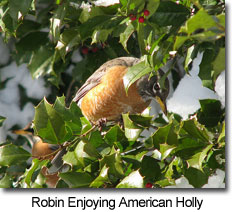
American Holly
(Ilex opaca)
American hollies grow from 15-50 feet tall and produce red, fleshy berries that are available throughout the winter. Birds are the principal consumers of American holly fruit, although deer, squirrels and other small animals eat them. At least 18 species of birds, including songbirds, Mourning Doves, wild turkeys and Northern Bobwhite Quails, are known to eat the fruit.
Arborvitae
(Thuja occidentalis)
Arborvitae, also known as Northern white cedars are tall, cylindrical trees. Their dense foliage provides excellent cover year round for wildlife. Species such as songbirds, waterfowl and small mammals all benefit from Arborvitae. This tree grows best in wet, calcareous (calcium-rich) soils.
Eastern Red Cedar
(Juniperus virginiana)
Eastern red cedars can grow in any region of Maryland and are found in dry-moist soils. This tree has scale-like leaves and produces bluish-green berries from July-March. Many birds and small mammals eat the berrylike cones of eastern red cedar, especially in winter. Wildlife species that eat eastern red cedar fruits include Cedar Waxwings, Bobwhite Quail, Ruffed Grouse, Ring-necked Pheasant, wild turkeys, rabbits, foxes, raccoons, skunks, opossums and coyotes.
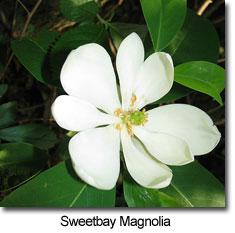
Sweetbay Magnolia
(Magnolia virginiana)
Sweetbay vegetation is used by a variety of wildlife species. Squirrels, other small mammals, song birds wild turkeys and Bobwhite Quail feed on sweetbay seeds. Deer browse sweetbay leaves and twigs throughout the year. Sweetbay leaves are also used in nest construction by several bird species such as Eastern Kingbirds, Northern Mockingbirds, American Robins, Wood Thrushes and Red-eyed Vireos.
Pines
(Pinus spp.)
Pine trees are fast growing trees that provide tremendous wildlife benefits. Songbirds and small mammals benefit the most from pine trees. Pine cones are a great food source year round.
Deciduous Trees
Although deciduous trees lose their leaves in the fall and winter, they still provide cover and food important for wildlife. Leaf litter from deciduous trees also provides food and cover for many invertebrate species. Maryland has a greater diversity of deciduous trees, and many deciduous trees produce flowers and fruit beneficial for wildlife. The following list contains deciduous trees that can enhance your backyard habitat. Hyperlinks are provided for species with additional fact sheets.
American Beech
(Fagus grandifolia)
American beech trees are one native deciduous tree which can tolerate shade. Planting this tree in a shady backyard will provide nuts for songbirds and squirrels, sap for Yellow-bellied Sapsuckers and buds for finches.
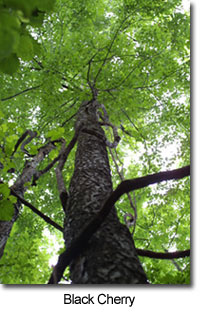
Black Cherry
(Prunus serotina)
The black cherry can grow to 50 or 60 feet tall. Many birds and small mammals eat black cherries. It is the preferred fruit of birds like American Robins and Northern Mockingbirds. Black cherry sap is a favorite of the Yellow-bellied Sapsucker, a type of woodpecker. The Tiger Swallowtail also uses Black Cherry as a larval host plant.
Hickory
(Carya sp.)
The most common hickory species is the bitternut hickory. Songbirds such as grosbeaks, some woodpeckers, and other animals like fox, squirrels and chipmunks eat hickory nuts. Shagbark hickory, which has shaggy, plated bark also provides cover for roosting bats.
Maple
(Acer sp.)
Maples also have winged seeds which are eaten by cardinals, evening grosbeaks, bobwhite quail, and other animals. Grosbeaks and American Goldfinches use the leaves for nesting material and also use the branches for supporting their nests. Maple sap is eaten by squirrels and songbirds and the sugar maple, found in western and central Maryland, provides sap for maple syrup.
Oaks
(Quercus sp.)
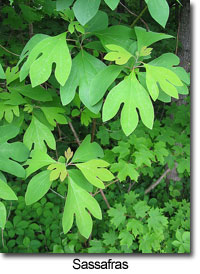
There are five types of oaks native to Maryland: the black, white, scarlet, red and pin oaks. Many songbirds, ducks, and other animals eat the acorns. Squirrels are famous for hiding acorns to get ready for the long winter. Deer eat oak leaves and twigs. Oaks provide branches for bird nests and hollows for woodpeckers, squirrels and other animals to raise their young in wooded protection. The leaves and branches provide shade and protection from the weather.
Sassafras
(Sassafras albid
um)
The sassafras tree is common along fencerows, roadsides and abandoned fields. It is not often used by birds for nesting but its blue fruits are a favorite of Gray Catbirds, American Robins and Eastern Bluebirds. In the fall, sassafras trees are in beautiful color with orange leaves, blue fruits and green stems. The Spicebush Swallowtail also uses Sassafras as a larval host plant.
Tulip Poplar
(Liriodendron tulipifera)
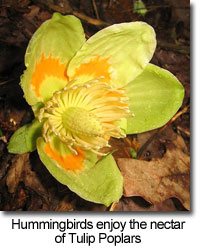
The tulip poplar is a fast-growing, tall North American hardwood tree that can reach a height of over 150 feet! Hummingbirds enjoy its nectar, while Yellow-bellied Sapsuckers enjoy its sap. Tulip poplars produce seeds, which are favorites of Northern Cardinals. Hollow spaces inside this tree provide homes for squirrels and raccoons, among other animals.
White Ash
(Fraxinus americana)
The white ash grows in moist soils and can grow from 50-100 feet. It is the most common of the ash species, while the green ash (Fraxinus pennsylvanica) is the most widespread. You will know the ash by its winged seeds which are consumed by many bird species. The seeds are favorites of Evening Grosbeaks and Purple Finches and are also eaten by Northern Cardinals, Northern Bobwhite Quail and Wood Ducks.
Tips for Using Trees to Attract Wildlife
- Plant a variety of tree species
- Try to arrange trees and shrubs in groups together or in hedgerows
- Avoid planting trees and shrubs in isolation from other vegetation, following your garden center’s advice on how far apart your trees should be planted
- Try to plant some trees that grow tall and some that are not so tall, some that have bushy crowns with relatively bare trunks and some that have thick leaves and branches from the ground up
- Wildlife species and insects sometimes will use special food and shelter sources found only in certain parts of trees. Planting trees with vertical diversity increases your chances of having a greater variety of species on your property.
- Be sure to plant some evergreens. For wildlife, evergreens provide shelter all year long, especially in winter when other trees have lost their leaves.
- Remember that trees take time to grow. Fast growing species include sumac, red maple, alder and white pine. Consider the time it will take your trees to grow when preparing your tree planting plans.
- If you do not have mature trees nearby, nest boxes for birds and other wildlife can help provide shelter for those species, which use hollows or cavities in trees for nesting.
How to Plant a Tree
- Remove all wires, ropes, or burlap surrounding the roots of the tree.
- Dig a hole five times the diameter of the root ball, but approximately the same depth of the root ball.
- Set the tree in the center of the planting area so that the upper surface of the root ball is level with the surrounding soil.
- Fill the hole with soil.
- It is preferable not to stake or wrap the tree to stabilize it.
- Use water to pack or settle the soil around the root ball and apply a two to four inch layer of mulch over the entire planting area.
For Additional Information on Trees:
Visit DNR's Forest Service webpage or check out tree fact sheets provided by Virginia Tech.
Or, contact your State Project Forester or the Annapolis Office of the Forestry Service
410-260-8531 (Toll-free in Maryland: 1-877-620-8DNR, ext. 8531).
Invite Wildlife to Your Backyard!
For more information, please contact:
Maryland Department of Natural Resources
Wildlife and Heritage Service
Tawes State Office Building, E-1
Annapolis MD 21401
410-260-8540
Toll-free in Maryland: 1-877-620-8DNR
[email protected]
Acknowledgements:
- Black Cherry Tree Photo courtesy of (c) 2002 Steven J. Baskauf, Bioimages home
- All other photographs by Kerry Wixted